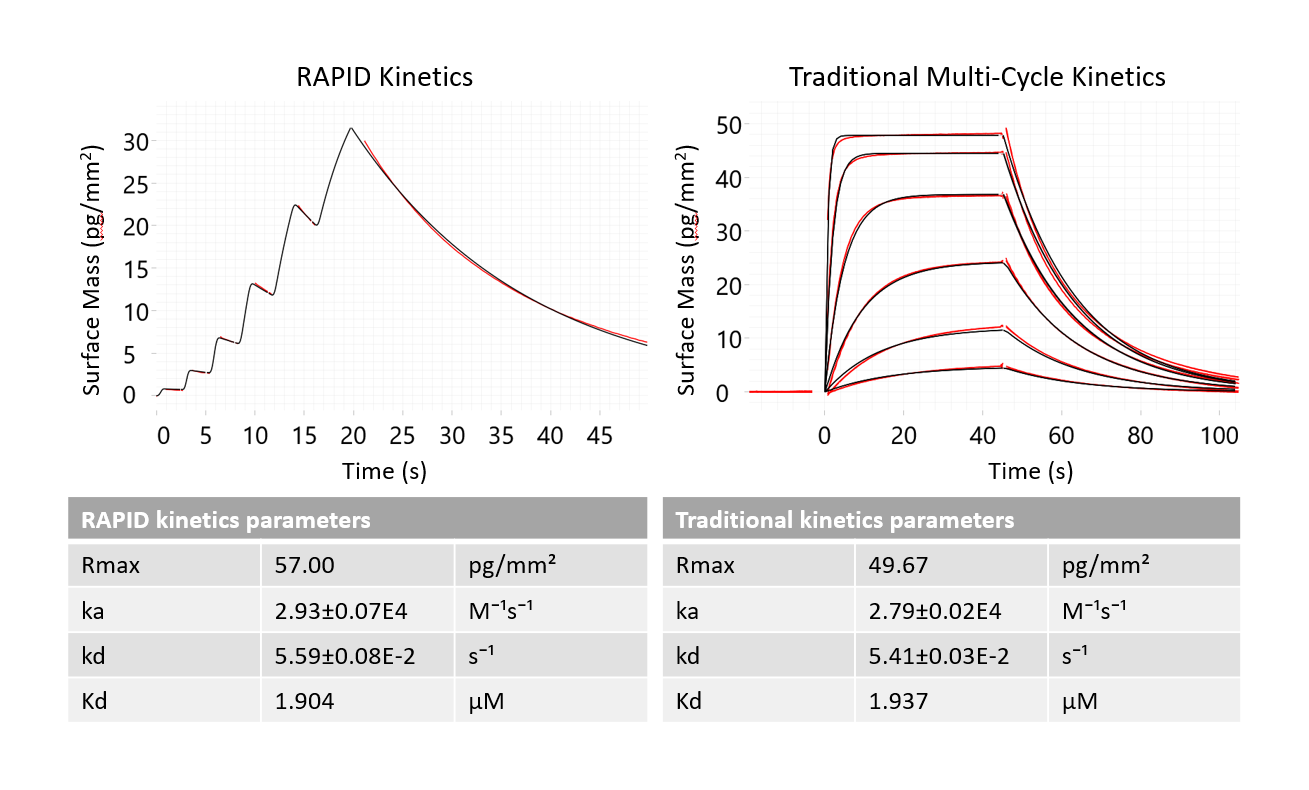Grating-coupled interferometry (GCI) is a surface based, a label-free optical sensing technique used for real-time binding kinetic measurements.1 Typically, GCI is used to detect binding events between a target molecule and an analyte. When a protein immobilised on the sensor surface binds to an analyte, there is a light phase shift, which is read out interferometrically. The binding kinetics are analyzed by measuring these phase-shift signals in real time.
The long light-to-sample interaction length of the waveguide provides intrinsically high signal-to-noise levels. In addition, the microfluidic chip used in the GCI biosensor has a unique design that allows ultra-fast transition times for reliable determination of fast off-rates.1
Advantages
One of the main advantages of GCI as a method for biophysical characterization is its incredible sensitivity. The high signal-to-noise ratio means that very weak signals can be detected – so even rare binding events or samples with very low concentrations can be measured with this method.
As GCI is a label-free technique with no-clog microfluidics, this minimizes the amount of sample preparation needed and makes GCI a technique suitable for use with a number of analyte/sample pairs.
GCI can also be used in conjunction with the waveRAPID method – a fast-transition fluidics method for the measurement of binding kinetics.2
WAVEsystem solution
The WAVEsystem solution for binding kinetics is a GCI technology-based instrument that allows for robust, full resolution of a wide range of binding kinetics, from low pM to low mM with signals below 1 pg/mm2 and off-rates from 10^-6 and sec^-1. Using a no-clog microfluidic sensor chip, the WAVEchip at the heart of the device is compatible with multiple immobilization and capture strategies. The versatility of the samples and analytes that can be used with the WAVEchip is what has made it so successful in a range of different applications, including fragment-based screening, kinetic analysis of small molecules binding to target proteins and the study of protein-protein, protein-peptide and antibody antigen interactions.

Results of kinetic interaction analysis between small molecules and fibrils.
Image Credit: Malvern Panalytical

Binding to GPCRs from crude membranes.
Image Credit: Malvern Panalytical
Owing to the unique and powerful analysis software, direct kinetics, it is possible to recover complex kinetic information in just a single click. Making use of the GCI technology, the system has excellent signal-to-noise and so can work with low immobilization levels and is also compatible with large ligand-to-analyte molecular weight ratios.
The WAVEsystem is also highly sample efficient. With waveRAPID, a single well is all that is required in terms of the sample, and there is no sample evaporation thanks to the temperature-controlled autosampler. The instrument is capable of 120 hours of unsupervised operations, with a capacity of 96 to 384 well plates.

Flexibility of measuring kinetics.
Image Credit: Malvern Panalytical
The innovative fluidics design with fast transitions between buffer and sample, means no data is missed and making it possible to capture even the fast transition times. The lack of integrated valves makes sticky samples clogging the microfluidics not an issue, meaning instrument downtime is significantly reduced, makes maintenance easier and minimizes the risk of problems.
For drug discovery, the WAVEsystem can accelerate screening of compounds by providing the ultimate efficiency for measuring binding kinetics as well as a superior time resolution for capturing even the weakest of binding events. This highly versatile platform is ideal for a large number of both purified and unpurified compounds and will allow users to analyze these larger and more complex datasets in just a single click.

Results from analysis of two antibodies in buffer with and in 90% serum” (or if too long, Antibody profiling in 90% serum).
Image Credit: Malvern Panalytical
With a sensitivity range from pM – mM, high degrees of automation and ultimate data reliability, the WAVEsystem is the ideal choice when it comes to the biomolecular interaction analysis of samples. Contact Malvern Panalytical today to find out more about what the WAVEsystem can do for you.

WAVEsystem solution for binding kinectics.
Image Credit: Malvern Panalytical
References and further reading
- Patko, D., Cottier, K., Hamori, A., & Horvath, R. (2012). Single beam grating coupled interferometry: high resolution miniaturized label-free sensor for plate based parallel screening. Optics Express, 20(21), p. 23162. https://doi.org/10.1364/oe.20.023162
- Kartal, Ö., Andres, F., Lai, M. P., Nehme, R., & Cottier, K. (2021). waveRAPID—A Robust Assay for High-Throughput Kinetic Screens with the Creoptix WAVEsystem. SLAS Discovery, 26(8), pp. 995–1003. https://doi.org/10.1177/24725552211013827
About Malvern Panalytical

Malvern Panalytical provides the materials and biophysical characterization technology and expertise that enable scientists and engineers to understand and control the properties of dispersed systems.
These systems range from proteins and polymers in solution, particle and nanoparticle suspensions and emulsions, through to sprays and aerosols, industrial bulk powders and high concentration slurries.
Used at all stages of research, development and manufacturing, Malvern Panalytical’s materials characterization instruments provide critical information that helps accelerate research and product development, enhance and maintain product quality and optimize process efficiency.
Sponsored Content Policy: News-Medical.net publishes articles and related content that may be derived from sources where we have existing commercial relationships, provided such content adds value to the core editorial ethos of News-Medical.Net which is to educate and inform site visitors interested in medical research, science, medical devices and treatments.